Hockey legend Marian Hossa recently published a memoir, “My Journey from Trencin to the Hall of Fame”. This autobiography comes in conjunction with his No. 81 being retired by the Chicago Blackhawks in the United Center rafters this Sunday, Nov. 20, 2022. It’s a highly entertaining and informative read, following Hossa’s life and career from his childhood in Slovakia, throughout his 19-year NHL career, to the present day with his upcoming honor in Chicago.
Related – Blackhawks’ Legend Marian Hossa & His Hall of Fame Career
Hossa addresses his audience in first person in the book, just like he’s sitting there having a conversation with you. The full-size, smiling photo of him on the cover is helpful in that regard. Hossa also commissioned Scott Powers, best known for his journalistic work with The Athletic, as his co-author. Powers obtained interviews with Hossa’s friends, family, teammates, coaches, you name it. It’s an excellent way to supplement Hossa’s own words to round out all the intricate details about the life of this amazing man.
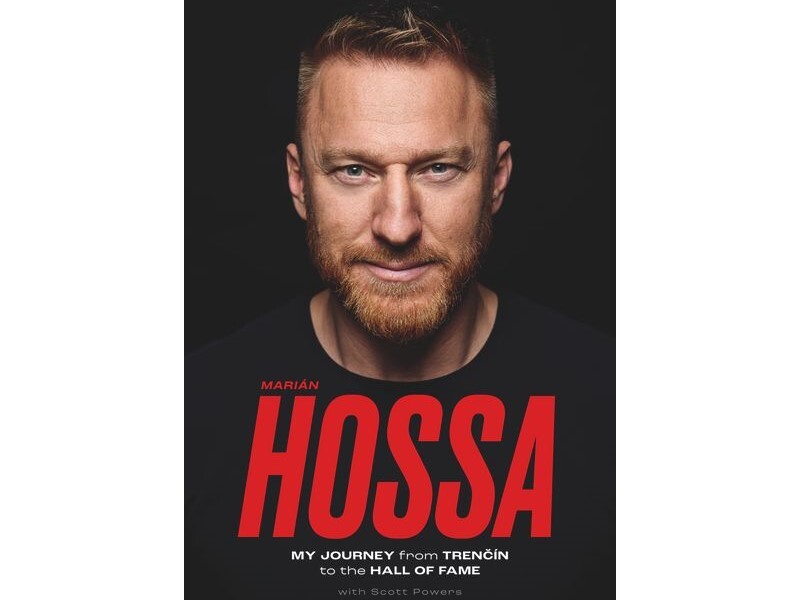
In this book review, I’ll attempt to give you what I see as the highlights of Hossa’s journey through his life and hockey. But beware; this will likely just whet your appetite for more. The manuscript covers a lot of ground, but there was no part of the nineteen detailed chapters that I wanted to skim through or skip ahead. In this writer’s humble opinion, it’s a must-read for any hockey fan, especially Blackhawks fans.
The Perfect Hockey Player
Hossa asked Joel Quenneville, the coach he won three Stanley Cups with, to write the Foreword for the book. In typical Quenneville fashion, the former bench boss got straight to the point with this first sentence:
When I think of Marian Hossa, I think of the perfect hockey player – no maintenance, smart, comes to play every night, plays the right way, plays in all situations.
Q goes on to discuss how Hossa always did the right things in the right areas, and as a coach he was spoiled to have him on his team. He said Hossa just quietly did his job, and was the most respected guy because he was such a “nice, classy player, a classy guy”.
He spoke a little bit about how it was a no-brainer to put Jonathan Toews and Hossa together. “I think certain individuals play the game to score points or get goals. Those two guys played to win the game, and I think as a coach you don’t have a bigger appreciation for anything than that…having players that make the team a priority.”
Quenneville ended by saying he was flattered and honored “Hoss” asked him to write the foreword. “He’s a tremendous man, a tremendous family man, and the Slovakians got a special, special hockey player.”
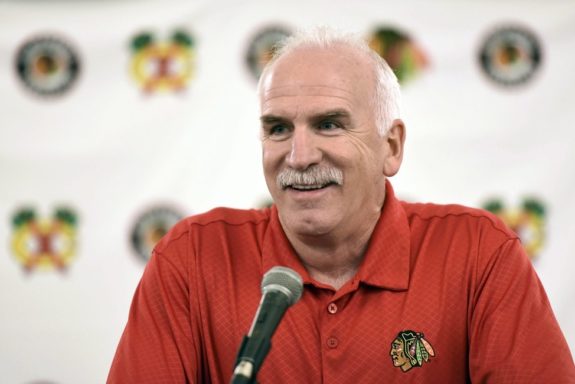
Along with Hossa being the “perfect player”, Quenneville was the perfect man to write the foreword and set the tone for the book.
Hard-Nosed Hossa
In the Introduction, Hossa does just that. He attempts to acquaint himself with the reader. One of the first things he feels it’s important for you to know is that he likes to be prepared, and that includes being organized. He proceeds to tell an extremely funny anecdote involving his wife, Jana.
(Jana) recently wanted a new vacuum, a smaller one, for the kitchen…I wanted to do some research before we bought one. There was one from a German company, Miele, I thought was the best from what I had read, but she liked another one. She’s like, ‘Jesus Christ, I can’t even buy the vacuum I like’. I told her you can buy the one you like, for sure, but I was going to buy the Miele one as well, because I knew it was better. She responded, we don’t need two vacuums in the kitchen. So, we bought the vacuum I liked, and it’s great.”
Well, there you have it! Hossa is meticulous in his everyday life as well as in his hockey life. All I can say is, poor Jana! She actually gets a chance to counter this a little bit later in the book. I’ve included some of her comments in the family section.
Hossa’s Early Career
The first few chapters of the book outline the start to Hossa’s NHL career.
Ottawa
He was drafted by the Ottawa Senators in 1997 as the 12th overall pick when he was 18 years old. He only played for seven games in the 1997-98 season before being sent down to the WHL Portland Winterhawks. While this was disappointing at the time, Hossa talks about how much he learned there. He scored 58 goals and produced 104 points in 69 games between the regular season and the playoffs, and was voted the league’s rookie of the year. The team also won the Memorial Cup, so Hossa gained a lot of playing time while experiencing a winning environment.
Related – Reasons For Patrick Kane’s Scoring Slump
From there Hossa talks about his six seasons with the Senators, and playing with some big names including the Senators’ captain, defenseman Daniel Alfredsson. He was hoping to sign an extension when he became a restricted free agent after the 2003-04 season. But general manager John Muckler wasn’t willing to pay the salary that was the going market for Hossa’s skill set. They went to arbitration, and Hossa ended up being dealt to the Atlanta Thrashers.
Atlanta
It was tough to go from a big hockey market in Ottawa to a non-hockey market in Atlanta. Bob Hartley was the coach and he was really hard on the players, especially the young ones. But if you played the right way, he liked you. So Hossa didn’t really have too much of a problem with him.
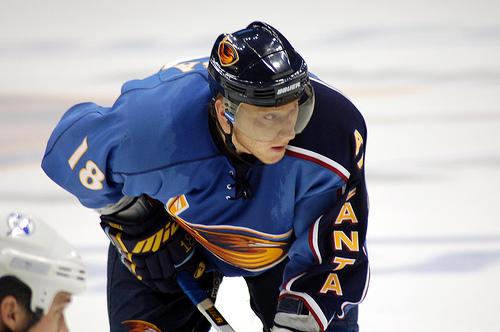
Hossa never scored 50 goals in a season, but he had 45 one year in Ottawa, and 43 another year in Atlanta. There were some other milestones in Atlanta; he compiled 100 points in his second season, and there was a season where he scored seven shorthanded goals. This was also where he started his charity, HOSS Heroes, helping underprivileged children. He continues this charity to this day in Slovakia.
(Other contributions to the community for Hossa include a multi-sport recreation center, and a rebranded food distribution company he started with his cousin many years ago. He discusses these business endeavors later in the book.)
Pittsburgh
Hossa with in his ninth NHL campaign and had turned 29 in the 2007-08 season. At the end of the season, he told the Atlanta owners he would only consider re-signing if they brought in some more quality players for a better chance to go farther in the playoffs. They all knew that wasn’t going to happen, so they traded him to the Penguins on Feb. 26, 2008 at the trade deadline.
Here, he was thrust into young group including the talented Sidney Crosby and Evgeni Malkin, but they had never gone far in the playoffs. Michel Therrien was the coach, and the players all warned Hossa he was really hard on them. But Hossa thought Therrien was a big softie compared to Hartley in Atlanta. He goes into detail about his short amount of time in Pittsburgh and their playoff run where they eventually lost to the Detroit Red Wings.
Hossa’s Decision to Sign With the Red Wings
Now, most people know how Hossa competed in three Stanley Cup Finals in a row, losing with the Penguins and then the Red Wings before winning with the Blackhawks. But did you know he turned down a couple very lucrative contract offers to sign a one-year deal with the Red Wings?
Hossa was in the handshake line when the Red Wings beat the Penguins in the Cup Final, and Red Wings head coach Mike Babcock said to Hossa, “Come to Detroit next year. We really want you.” He already had Detroit on his radar as a team he could learn from. He saw the advantages of playing with legends like Pavel Datsyuk, Henrik Zetterburg, Chris Chelios and Nick Lidstrom. He thought the experience would help him to be a better player in the long run.
So Hossa passed up on a five year, $7.5 million a year deal with the Penguins, as well as a huge potential $80 million deal with the Edmonton Oilers. But the story doesn’t end there.
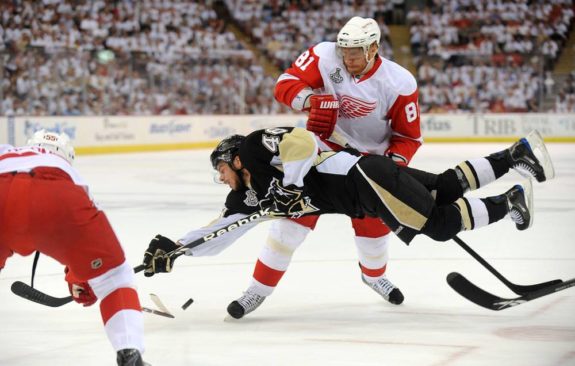
When Hossa determined Detroit was the place for him, he knew the team had a cap situation where they would only be able to sign him short term. Negotiations started at one-year and $8.5 million, and apparently ended up at one-year and $8 million. But Red Wings’ general manager Ken Holland wanted to call their captain, Lidstrom, and make sure he was ok with someone making more money than his $7.5 million. As soon as Hossa got word of this, he immediately said he would sign for $7.4 million instead. Hossa had obviously made his decision, and the opportunity to play with the best was a lot more important than the money. In the long run, it ended up being more about the opportunity than the money.
Now, we all know Hossa and the Red Wings ended up losing to his former team, the Penguins the next year. But Hossa says he still doesn’t regret his decision, because of what he learned that year and was eventually able to pass on to a young Blackhawks’ squad. He claims he learned how to play a proper 200-foot game, and how to be stronger mentally.
Transition From Detroit to Chicago
Our friend Marian actually gives some great insight about his time with the Red Wings, specifically playing with Datsyuk. After practice, they had a routine where they used to take turns trying to take the puck away from each other. Hossa says this helped him so much defensively. He actually took this game to Chicago and taught it to the guys there. He said he loved that game and couldn’t wait until practice was over so they could play it.
By the way, as I mentioned before, the book is peppered with interviews from friends and teammates. Co-author Powers even got some words from the quiet and introverted superstar Datsyuk. “He (Hossa) was always a team player on any team. He respected the team’s interest over his own…He also was never afraid of the dirty work.”
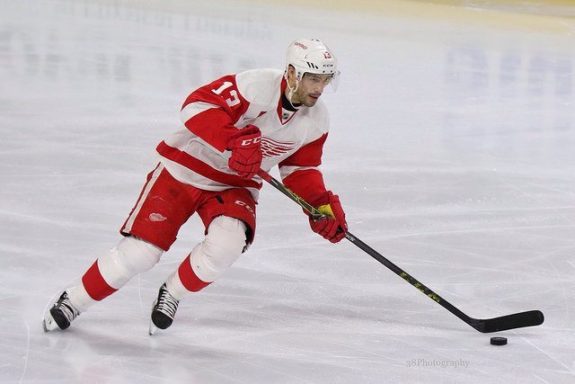
Powers also obtained interviews from Blackhawks’ superstars Toews and Kane, and it was interesting to get their perspective. But you’ll have to read the book for that. Instead, I’d like to share a few other stories from Hossa about his time in Chicago. The first is when he had just signed with the team and went to the Blackhawks Convention over the summer. In the evening, the players got together in a hotel room. Hossa described the scene.
I had just come from Detroit where I was drinking wine with Nick Lidstrom and Chris Chelios. There, it had been really calm, and everyone had their own kids. And then I came to a team like Chicago, and they were like kids themselves. They were jumping on the bed, making a mess, doing pranks. I thought to myself, this is fun, this is going to be great. That’s how it was on the ice too.
The second story is when the Blackhawks won the Cup for the first time in 2010. Remember, this was Hossa’s third Final in a row, and he was feeling the pressure. Before Game 6 and after their team lunch, Toews and Hossa rode in the elevator together on their way back to their hotel rooms. Hossa reveals,
Jonny turned to me and said, “Hoss, just in case, be ready. Because if things go right tonight, you’re going to be the first guy I give the Cup to”.
…this 22-year old kid is so confident and was willing to say what he said. It ended up really helping me. It was amazing he told me that. It calmed me and allowed me to think about the game as any game and hope everything went right.
Hossa Speaks on the Selke
We all know the Selke Trophy is awarded annually to the NHL forward who demonstrates the most skill in the defensive component of the game. It’s become customary over the years for this trophy to be awarded to a center. But what about those wingers just like Hossa who are also excellent two-way players?
In the book, Hossa talks about how happy he is to have had such a successful career. But he laments the fact he never won an individual trophy. He mentions the Selke, and his frustration with the way it’s determined.
I thought there was one season with the Blackhawks I might have a chance with that because of my plus-minus, backchecking, and penalty-killing ability, but I didn’t get many votes because I didn’t play center…They should call it the center’s trophy or something, because you have great defensive wingers and they’re not even considered. It definitely sucks for wingers.
That does it; we need to start a petition for a new NHL award, specifically for the best defensive winger. We can call it the Hossa Trophy!
The Skin Condition That Forced Retirement
Hossa was forced out of the game due to a skin condition, which is now common knowledge. But back when it was happening, the veteran hockey player was able to keep it under wraps for a long time. He opens up about this for the first time, and gives some pretty gory details.
Not to gross you out, but what would happen is there would be pus leaking from my skin if it didn’t have enough time to breathe. The pus was a yellowish color. It was ugly and more so it made me uncomfortable. After the pus dried, my skin would blister. Those blisters itched and then I began scratching them and then there was blood.
Oh, my. Tell me less!
They thought he was allergic to something, and tried so many things to alleviate the problem. But nothing worked. Finally, Hossa resorted to an anti-rejection drug. In Blackhawks’ head physician Michael Terry’s words, it’s a “medication that we give people who have organ transplants so that they don’t reject the organs.”
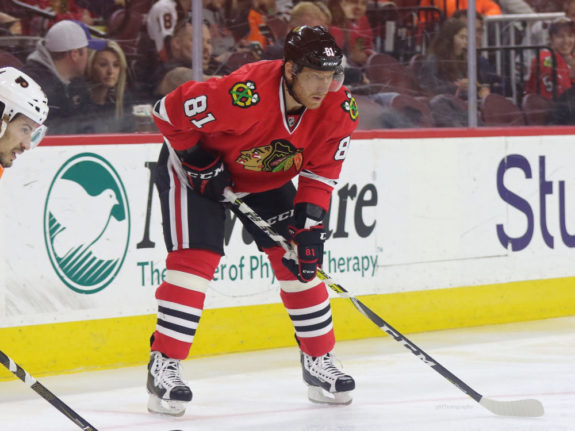
These are heavy drugs that can cause serious side effects as well as kidney damage. Hossa knew he couldn’t take these kinds of risks with his body long term. He decided it was time to be done. He explains how when he finally made this decision he put the cyclosporine pills down the garbage shoot, much to the relief of his wife.
Family First
Marian’s married his wife Jana in 2010 after he won the Cup for the first time, and they’ve been together for over 20 years. There are some great stories in the book about how they met, courted, and navigated Marian’s career with family life.
There’s a very enlightening excerpt from Jana, which gives a little bit of a different perspective on the vacuum cleaner story from the beginning of this article. It turns out Jana now runs a yoga studio back in Slovakia, while Marian takes the girls to school. Their roles have been reversed, and now the husband is supporting his wife’s career after she wholeheartedly supported his.
Related – 5 Games That Define Marian Hossa’s Career
Oh, and Marian let the cat out of the bag when he revealed a new addition to the family! The Hossa’s now have a third daughter, besides Mia and Zoja. Baby girl Hossa is with the rest of the family for the jersey retirement ceremony visit this week.
Hossa also goes into detail about how his parents supported him growing up, and how he and his brother Marcel both attained their childhood dream of making it to the NHL. It’s obvious that family is very important to this legendary man.
Hall of Fame & Jersey Retirement
Hossa says he never thought about being inducted into the Hall of Fame. But then towards the end of his career people kept saying how it could be possible. He had, after all, played more than 1000 games (1309 overall), scored more than 500 goals (525) and won three Stanley Cups.
For me, I just wanted to be remembered as a player who played the game the right way, who competed, and was multi-dimensional.
Nevertheless, Hossa disclosed he was honored and humbled to be voted in on the first year he was eligible. He recounts his incredible weekend, including the ring ceremony, a pre-game observance before a Calgary Flames and Toronto Maple Leafs’ game, playing in the Legends Classic game, a surprise Stanley Cup visit, dinner with some former Blackhawks’ teammates, and the Hall of Fame Ceremony itself.
Hossa was introduced by his former Red Wings’ teammate and captain Nick Lidstrom, who he took a pay cut for years earlier during contract negotiations. He also thanked his former Slovakian coaches in their native language, something that was very special to him.
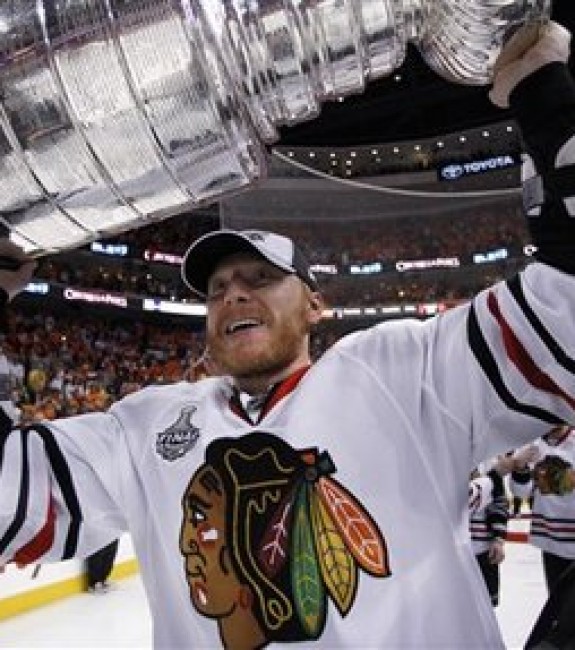
In April of 2022 Hossa was able to attend Toews’ 1000 game ceremony. This trip is also when he signed his one-day contract to officially retire with the Blackhawks. The Blackhawks also announced Hossa’s No. 81 jersey would be retired. As we now know, this jersey retirement will transpire on Sunday before the Blackhawks/Penguins game.
What a fitting way for Marian Hossa to go out! The hockey fairy tale has run its full course, and it sounds like Hossa is truly leading an enjoyable and blessed retirement as well. I’ll end this book review with the last few sentences of his autobiography, where Hossa describes the emotions of having his name and number raised to the United Center rafters.
It’s not something you ever think about. It’s really an amazing feeling. I know that will be up there long after I’m gone. That will be part of my legacy. There aren’t many players who have been given that honor, and I feel so lucky and grateful that it’s happening to me. I couldn’t have dreamed for a better ending to my hockey career.
